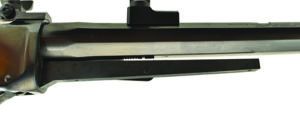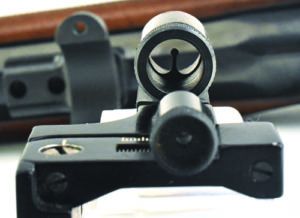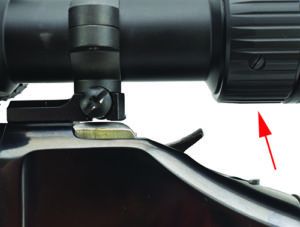GUN TESTS GRADE: A
$1100
Two of the prime advantages of a lever-action rifle are that they are thin and flat. In other words, very easy to carry on horseback or just in back of the seat in your truck. Many, including our test rifles, are relatively light and fast handling. Our Browning High Wall is also a flat, thin lever action. However, it is a single shot, and that brings its own set of advantages and disadvantages. The falling block, single-shot High Wall does not require the longer actions of the Marlin and the Henry because it does not need to feed, move, and eject the full length of the cartridge while enclosed completely inside the action. The shooter pushes forward on the lever, the breech block lowers, thus exposing the chamber, and a cartridge is either loaded or ejected.
| Action Type | Lever action, single shot falling block |
| Overall Length | 44.0 in. |
| Barrel Length/Twist | 28.0 in., 1:20 |
| Overall Height w/o Scope Mount | 6.5 in. |
| Weight Unloaded | 8.25 lbs. |
| Weight Loaded (325 grain, 1 round) | 8.33 lbs. |
| Sight Radius | 21.7 in. |
| Action Finish | Polished blue |
| Barrel Finish | Polished blue |
| Magazine Capacity | 1 |
| Magazine Type | Single shot, breech loader |
| Stock | Walnut |
| Drop at Comb | 0.75 in. |
| Drop at Heel | 1.25 in. |
| Bedding | None |
| Buttplate | 0.5 in. recoil pad |
| Length of Pull | 13.25 in. |
| Receiver Scope-Base Pattern | Browning High Wall |
| Trigger Pull Weight | 2.5 lbs. |
| Safety | Half cock notch on hammer |
| Warranty | None |
| Telephone | (800) 333-3288 |
| Website | WinchesterGuns.com |
| Made In | Japan |
Maximum acceptable cartridge length in the High Wall’s receiver is about 3.5 inches, compared to 2.6 inches or so for the Marlin and the Henry — at least the maximum length must be shorter if you want the action to feed and cycle properly. That means the engineer can use that space for something else and keep the rifle the same overall length. In many cases, that means a longer barrel. We compared our High Wall to a Tikka T3 we had on hand with a 24-inch barrel. The Browning, with its 28-inch barrel, was an inch shorter than the Tikka. Longer barrels can allow for a longer sight radius, but mounting a scope renders that a moot point. The longer barrel may also extract more velocity from the same cartridge in a shorter barrel. Velocity and the improved ballistics that usually brings can be a very desirable attribute, especially when one wants to shoot at any kind of extended ranges. Velocity combined with bullet weight also generate more muzzle energy, which comes in very handy when one is about to shoot something that can bite back. The bad thing about a single shot is that it is, well, a single shot. Follow-up shots, when really needed, are problematic.

The barrel on our sample was octagonal and sturdy, only tapering down to 0.75 inch at the muzzle. The flats are smooth and well-polished, but the edges are rounded. Just for cosmetics’ sake, we really wish that Browning had left those sharp. The High Wall utilizes a two-piece stock set. That frequently means that the forend is mounted, in some way, directly to the barrel. This John Moses Browning-designed rifle free floats the barrel by attaching the forend to a very sturdy hanger protruding forward from the action. This may well be one of the reasons it shoots as well as it does. The barrel crown is well recessed, and a blade sight is set in a dovetail mount about an inch back from the muzzle. The factory rear buckhorn sight extends from a dovetail that is cut about 6.5 inches forward of the receiver, allowing about as long a sight radius as possible given the curves on the barrel. We removed the rear sight, leaving that dovetail open, and then installed a scope using Talley light weight bases with integral rings. This system does a good job of securing the scope to the receiver, and you need that with some of the loads this rifle will shoot. However, the same method, depending on the optic chosen, can leave the ocular bell close to the hammer, making the latter difficult to manipulate. The forend is well checkered in almost any area that the shooter would want to grasp and ends in a slender, Schnabel tip. The rear stock has a straight grip that is also cleanly checkered.

The comb on the stock is high enough to be used properly with iron sights, but it is a little low for proper eye position when scoped. We added a Blackhawk IVS cheek rest from MidwayUSA (125776, $35) to give us a little more height. Also, the ammo-carrying capacity of this cheekpiece could be very desirable for someone shooting a single-shot rifle. The wood in the stock is a medium-dark walnut with some figure in the grain and a semi-gloss finish. The stock is supplied with two sling swivels that will also rotate. The rear stock is capped with a recoil pad that is only about a half-inch thick at the primary point of contact with the shoulder. It would really be nice if this pad were thicker and softer.

The action is a lever-activated falling block. When the “S” shaped lever is rotated forward, a massive breech block and the hammer are both lowered, exposing the chamber for loading a single round. Pulling the lever to the rear closes the breech and cocks the hammer. After firing, this motion is repeated, ejecting the spent case to the left, right, or virtually remaining in the action, as chosen by the shooter. This is changed via rotation of a slotted screw immediately aft of the hammer. The gold-plated trigger is a wide, serrated affair that breaks cleanly. It was very easy to predict and shoot. The user’s manual says that this trigger can be adjusted by rotating the screw immediately aft of the trigger. The shooter should be able to choose compression settings from 5 to as little as 3.5 pounds. Our sample required a very consistent 2.5 pounds with no early ignition or any other problems. So, we smiled and left it alone.
Just as a bit of advice, when shooting heavier recoiling rifles, watch for metal fatigue in your optics and mounts. We actually managed to shear the lugs off the base of a quality Leupold ring. They were admittedly well-traveled rings, having been used on a number of rifles and on the High Wall for some time. But just imagine our surprise when each of several succeeding shots were 3 inches higher at 100 yards than the previous efforts. On examination, we found the rear ring completely unattached to the base.
We started off with iron sights on the Browning as well, but used an aftermarket Williams combo with a peep rear and globe front. Visibility was very good, and accuracy was the best of the three sets of iron sights tested. They are also the most expensive.
We tested through the factory ammo, seeing very good results and a 100- to 150-fps more muzzle velocity than on the Marlin and the Henry. We thought that would be the case with the Browning having a 7.5- to 9.5-inch barrel-length advantage. Also, the longer chamber of this single-shot rifle really allowed it to stand out with hand-crafted ammo. We tested handloads with the High Wall using the same bullet in the factory Hornady 325-grain Flex Tip, but we were able to send it downrange over 300 fps faster than the factory load, while staying well within loading data limits. The real champ with the High Wall was the Barnes 350-grain TSX bullet handload at more than 2200 fps. Recoil was a little on the heavy side. We computed it to be more than 33 foot-pounds, compared to about 11 foot-pounds for a 30-30 Winchester). Using the Applied Ballistics Mobile app at a known 400-yard distance, getting a first round hit on a steel torso plate at American Shooting Center was easy and the 8-inch plate wasn’t that much of a challenge. Then we moved over to the 600-yard line — with a 45-70! We hit the torso plate first try, though the 8-inch plates turned out to be a bit more difficult. Even though remaining energy was still substantial, bullet drop at that distance was a little over 200 inches, and we would never dream of taking a game shot at that distance, but we did get to channel our inner Billy Dixon a bit. For what it’s worth, our scope adjustments on the High Wall with the 350-grain Barnes load at 400 and 600 yards were 4.5 mils and 8.8 mils, respectively. With a scope mounted right off the right side of the shooter and the sun behind us and to the left, the spotter could actually see the bullet sometimes. Not the trace — the bullet. Great fun.
Our Team Said: The 28-inch barrel, along with a single-shot design and the longer cartridge length that allows, let this rifle do things ballistically we did not think were possible with a 45-70. If you have room in the safe for this unique tool — that still has commercial ammo availability even in these times of tight ammo supplies — buy it.
45-70 GOVERNMENT RANGE DATA
All groups were shot at 100 yards from a solid bench using a Caldwell TackDriver front rest ($44 at MidwayUSA.com) and a T.A.B. Gear large rear bag ($30 at TABGear.com) with the heavy fill. Muzzle velocity was determined using a LabRadar chronograph ($559 at BuyMyLabradar.com). Location: American Shooter Centers (AMShootCenters.com) in Houston. NA = Not Available. The longer handloads wouldn’t chamber in those guns.| Remington HTP 300-grain TSX-FN | Browning High Wall | Marlin 1895G | Henry Lever X |
| Average Velocity | 1923 fps | 1804 fps | 1777 fps |
| Muzzle Energy | 2463 ft.-lbs. | 2169 ft.-lbs. | 2104 ft.-lbs. |
| Best Group | 0.58 in. | 0.59 in. | 1.70 in. |
| Average Group | 0.99 in. | 1.08 in. | 2.33 in. |
| Black Hills 325-grain HoneyBadger | Browning High Wall | Marlin 1895G | Henry Lever X |
| Average Velocity | 1878 fps | 1735 fps | 1824 fps |
| Muzzle Energy | 2547 ft.-lbs. | 2172 ft.-lbs. | 2401 ft.-lbs. |
| Best Group | 0.73 in. | 1.52 in. | 2.01 in. |
| Average Group | 1.14 in. | 1.55 in. | 2.36 in. |
| Hornady 325-grain Flex Tip | Browning High Wall | Marlin 1895G | Henry Lever X |
| Average Velocity | 2021 fps | 1876 fps | 1880 fps |
| Muzzle Energy | 2949 ft.-lbs. | 2540 ft.-lbs. | 2550 ft.-lbs. |
| Best Group | 0.86 in. | 0.95 in. | 1.58 in. |
| Average Group | 1.02 in. | 1.11 in. | 1.91 in. |
| Hornady Handload 325-grain Flex Tip | Browning High Wall | Marlin 1895G | Henry Lever X |
| Average Velocity | 2340 fps | NA | NA |
| Muzzle Energy | 3954 ft.-lbs. | NA | NA |
| Best Group | 0.77 in. | NA | NA |
| Average Group | 0.98 in. | NA | NA |
| Barnes Handload 350-grain TSX | Browning High Wall | Marlin 1895G | Henry Lever X |
| Average Velocity | 2221 fps | NA | NA |
| Muzzle Energy | 3833 ft.-lbs. | NA | NA |
| Best Group | 0.39 in. | NA | NA |
| Average Group | 0.65 in. | NA | NA |
| Speer Handload 405-grain JHP | Browning High Wall | Marlin 1895G | Henry Lever X |
| Average Velocity | 1643 fps | 1539 fps | 1537 fps |
| Muzzle Energy | 2427 ft.-lbs. | 2130 ft.-lbs. | 2125 ft.-lbs. |
| Best Group | 2.34 in. | 4.64 in. | 2.82 in. |
| Average Group | 2.43 in. | 4.71 in. | 3.06 in. |




























Can i get a browning high wall in a 30” barrel in 45/70